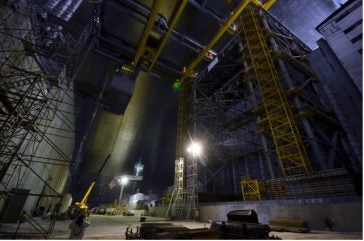
The Chornobyl Nuclear Power Plant (ChNPP) announced that a new project aimed at supporting restoration of safety, security and infrastructure has begun at the site. ChNPP is the client for the project, and Ukrainian company UTEM-Engineering has been contracted to act as consultant.
On 26 April 1986 ChNPP in northern Ukraine became the site of the worst ever nuclear accident. A massive explosion blew the roof completely off the reactor, which suffered a core meltdown. Radioactive materials and fuel were ejected into the surrounding environment. To prevent the continued release of radioactivity, a cover (sarcophagus) constructed under extremely difficult conditions and at great cost to those involved was completed in November 1986.
The dangers of working in such a contaminated environment meant that structural elements for the roof could not be fastened to supports, but were simply laid on top of them. Although designers suggested that the sarcophagus would last 30 years, holes in the roof structure remained in sections that workers could not reach.
In 1997, an international panel of experts, drew up the Shelter Implementation Plan (SIP) to stabilise the containment and make the site environmentally safe including construction of a monolithic shelter over the sarcophagus. To finance the project the Chornobyl Shelter Fund (CSF) was set up administered by the European Bank for Reconstruction & Development (EBRD).
In 2007 a consortium led by French firms Vinci Construction Grands Projects and Bouygues Travaux Publics won the tender to build the New Safe Confinement (NSC) to enclose the damaged facility. The new facility, with a 100-year design life, was constructed away from the sarcophagus and moved into place in 2016. Work to dismantle and stabilise the sarcophagus is currently conducted inside the NSC.
The original licence for decommissioning the sarcophagus, issued in 2019, envisaged completion by October 2023. An amended licence extended the service life of the sarcophagus to 2029 including shelter facility structures “whose collapse probability is very high”. A deadline of 2025 was set for development of a new design for unstable structure dismantling.
The CSF was closed in 2020 having received more than €2bn ($2.17bn) from 45 donors. The EBRD contributed €715m of its own resources in support of the work.
The new project is funded through a grant from the International Chernobyl Cooperation Account (ICCA), established in November 2020 by the EBRD at the request of the government of Ukraine, to support the development of a comprehensive plan for Chornobyl.
As part of this project, ChNPP will receive consultancy services for development of pre-design solutions for the NSC and dismantling of the sarcophagus. The project involves studying the condition of the shelter’s structures to determine which ones require immediate dismantling and which can be postponed. For the latter, surveys will assess whether these structures need stabilisation and what methods should be used.
The work also includes revising the criteria and requirements for the NSC infrastructure to support the dismantling of unstable structures in the shelter. This involves developing all necessary technical specifications, including for lifting equipment, systems for processing contaminated dismantled structures, their further transportation, engineering and control systems, additional radiation monitoring equipment, radiation-protected personnel transfer boxes, and other related documentation.
The result of the project will determine the scope of early deconstruction work for unstable shelter structures and provide an initial cost estimate. This will enable design work to begin for NSC Commissioning Stage 2, which includes the dismantling of unstable shelter structures.






